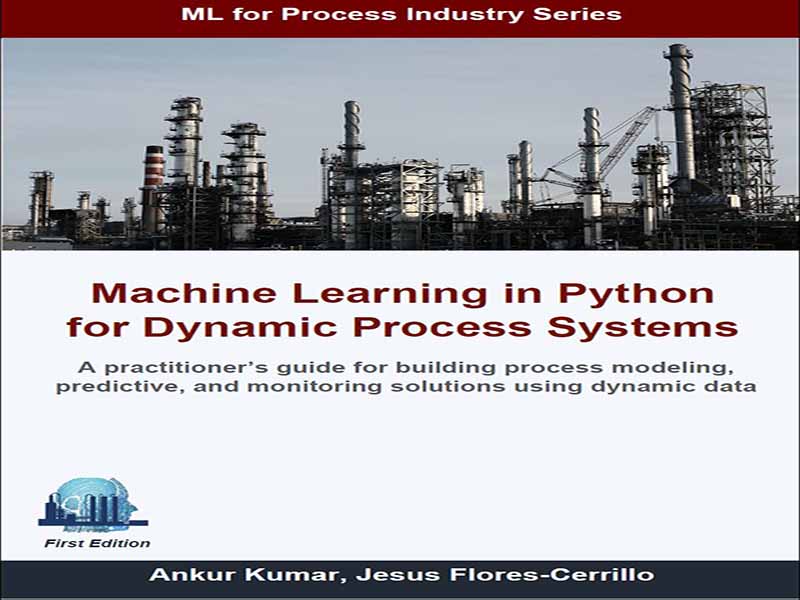- عنوان کتاب: Machine Learning in Python for Dynamic Process Systems
- نویسنده: Ankur Kumar
- حوزه: یادگیری ماشین
- سال انتشار: 2023
- تعداد صفحه: 208
- زبان اصلی: انگلیسی
- نوع فایل: pdf
- حجم فایل: 10.2 مگابایت
کنترل پیشبینی مدل (MPC) و بهینهسازی بلادرنگ (RTO) از جمله حیاتیترین فناوریهایی هستند که صنعت فرآیند را هدایت میکنند. هر مهندس فرآیند باتجربه ای تضمین می کند که موفقیت MPC ها و RTO ها به شدت به دقت مدل های فرآیند زیربنایی بستگی دارد. به طور مشابه، نیاز کلیدی برای سایر فناوریهای فرآیند مهم مانند تطبیق دادههای پویا، نظارت بر فرآیند، و غیره، در دسترس بودن مدلهای فرآیند دقیق است. تلاشهای مدلسازی در طول راهاندازی این ابزارها میتواند به راحتی تا 90 درصد از هزینه و زمان پروژه را مصرف کند. انقلاب دادههای مدرن، که به موجب آن مقادیر فراوانی از دادههای فرآیندی به راحتی در دسترس هستند، و مشکلات عملی در ساخت مدلهای دینامیکی با اصول اولیه با وفاداری بالا برای فرآیندهای پیچیده صنعتی، استفاده از مدلهای تجربی مبتنی بر داده/ماشین یادگیری (ML) را رایج کرده است. ساخت مدلهای پویا با استفاده از دادههای فرآیند، شناسایی سیستم (SysID) نامیده میشود و این یک زمینه بسیار بالغ با ادبیات گسترده است. با این حال، برای دانشمند داده های فرآیندی (PDS) که در این زمینه تازه کار است نیز بسیار آسان است که در ریاضیات SysID غرق شود و در دریای اصطلاحات SysID غرق شود. چندین کتاب قابل توجه ML در تجزیه و تحلیل سری زمانی نوشته شده است. با این حال، در صنعت فرآیند، مدل های ورودی- خروجی اهمیت بیشتری دارند. متأسفانه، کتابهای زیادی وجود ندارد که نیازهای PDSهای مدرن علاقهمند به مدلسازی فرآیند پویا (DPM) را برآورده کند، بدون اینکه آنها را با جزئیات ریاضی بیش از حد سنگین کند و انگیزه ما برای تألیف این کتاب در همین جا نهفته است: به طور خاص، خوانندهپسند و کتابی آسان برای درک که پوشش جامعی از تکنیکهای ML ارائه میکند که برای ساخت مدلهای فرآیند پویا با تمرکز بر پیادهسازیهای عملی مفید هستند. اکنون برای شما روشن شده است که این کتاب برای آموزش مهندسین فرآیند کار و PDS های نوپا در مورد DPM طراحی شده است. در حین انجام این کار، این کتاب سعی میکند از دامی که چندین کتاب عمومی ML در آن قرار میگیرند اجتناب کند: تأکید بیش از حد بر تکنیکهای «مدرن» و پیچیده ML مانند شبکههای عصبی مصنوعی (ANN) و درمان نادرست روشهای DPM کلاسیک. تکنیکهای کلاسیک مانند FIR و ARX همچنان بر راهحلهای مدلسازی پویا ارائه شده توسط فروشندگان تجاری راهحلهای صنعتی تسلط دارند و کمتر از ANNها «یادگیری ماشینی» نیستند. این دو به همراه سایر تکنیکهای کلاسیک (مانند OE، ARIMAX، CVA) پیش از دوران جنون ANN هستند و در ارائه عملکرد برابر (اگر نه برتر) در مقایسه با ANN در آزمون زمان ایستادهاند. به همین ترتیب، همراه با تکنیکهای مدرن ML مانند RNNها، بخش قابلتوجهی از کتاب به مدلهای دینامیکی کلاسیک با تأکید بر درک مفاهیم تصمیمهای مدلسازی مانند تأثیر فرض مدل نویز ضمنی با مدل ARX، دلالت دادههای متفاوت، اختصاص داده شده است. و غیره
Model predictive control (MPC) and real-time optimization (RTO) are among the most critical technologies that drive the process industry. Any experienced process engineer would vouch that the success of MPCs and RTOs depend heavily on the accuracy of the underlying process models. Similarly, the key requirement for other important process technologies like dynamic data reconciliation, process monitoring, etc. is availability of accurate process models. Modeling efforts during commissioning of these tools can easily consume up to 90% of the project cost and time. Modern data revolution, whereby abundant amount of process data are easily available, and practical difficulties in building high-fidelity first-principles dynamic models for complex industrial processes have popularized the usage of empirical data-driven/machine learning (ML) models. Building dynamic models using process data is called system identification (SysID) and it’s a very mature field with extensive literature. However, it is also very easy for a process data scientist (PDS) new to this field to get overwhelmed with the SysID mathematics and ‘drowned’ in the sea of SysID terminology. Several noteworthy ML books have been written on time-series analysis; however, in process industry, input-output models are of greater import. Unfortunately, there aren’t many books that cater to the needs of modern PDSs interested in dynamic process modeling (DPM) without weighing them down with too much mathematical details and therein lies our motivation for authoring this book: specifically, a reader-friendly and easy to understand book that provides a comprehensive coverage of ML techniques that have proven useful for building dynamic process models with focus on practical implementations.
It would be clear to you by now that this book is designed to teach working process engineers and budding PDSs about DPM. While doing so, this book attempts to avoid a pitfall that several generic ML books fall into: overemphasis on ‘modern’ and complex ML techniques such as artificial neural networks (ANNs) and undertreatment of classical DPM methods. Classical techniques like FIR and ARX still dominate the dynamic modeling solutions offered by commercial vendors of industrial solutions and are no less ‘machine-learning’ than the ANNs. These two along with other classical techniques (such as OE, ARIMAX, CVA) predate the ANN-craze era and have stood the test of time in providing equal (if not superior) performance compared to ANNs. Correspondingly, along with modern ML techniques like RNNs, considerable portion of the book is devoted to classical dynamic models with the emphasis on understanding the implications of modeling decisions such as the impact of implicit noise model assumption with ARX model, the implication of differencing data, etc.
این کتاب را میتوانید از لینک زیر بصورت رایگان دانلود کنید:
Download: Machine Learning in Python for Dynamic Process Systems



































نظرات کاربران